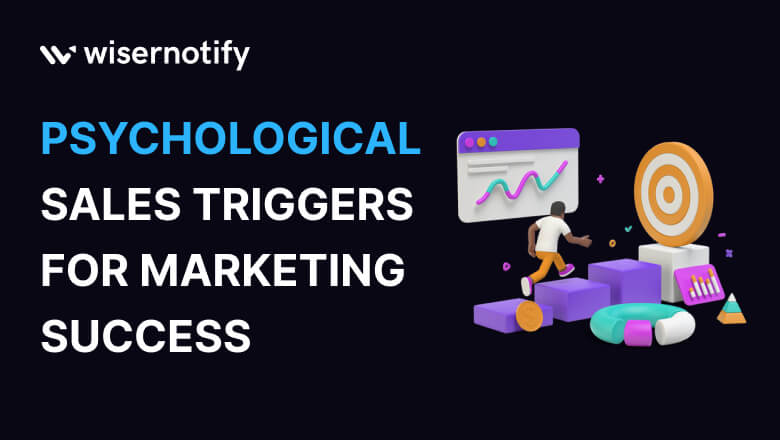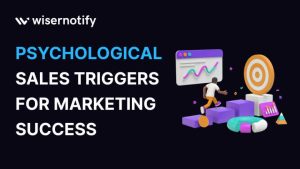Your customers are not always rational. In fact, most purchasing decisions are driven by deeply rooted psychological sales triggers that bypass logic.
Mastering these triggers can be the difference between a one-time sale and a loyal customer base.
Prepare to dive into the psychology of persuasion and learn how to ethically influence buying behavior.
Before diving into each sales trigger, how wisernotify boosts sales by triggering FOMO and showing social proof on your website.
This combination builds trust and confidence, encouraging consumers to take action.
Visitors leave your website without taking action?
They don’t trust your site or feel urgency to act. WiserNotify builds both, turning doubt into action & visitors into customers.
1. Psychological Sales Triggers
In the huge world of online shopping, persuading clients to pick your brand is critical. Understanding and using psychological sales triggers can be crucial in influencing purchase choices.
These triggers strike at the heart of human behavior, eliciting emotions and influencing consumer choices.
This article will discuss the significance of various psychological sales triggers and offer practical suggestions for implementing them into your online website or marketing initiatives.
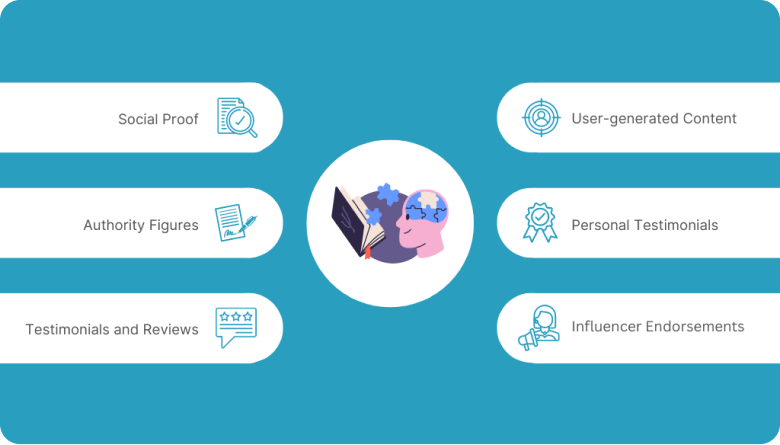
Social Proof: People like to see what others think before they make a choice. Show customer reviews and ratings to build trust. For example, TripAdvisor shows user reviews to help travelers decide where to stay.
Authority Figures: People listen to experts or famous people. Use industry experts or influencers to endorse your brand. For example, Rolex uses athletes and actors to show its watches are top quality.
Testimonials and Reviews: Share success stories from happy customers to attract new ones. For instance, Grammarly shares testimonials from users who improved their writing with the tool.
User-generated Content: Encourage customers to share photos, videos, or reviews of your products. This adds authenticity and builds community. GoPro, for example, showcases exciting videos made by its customers.
Influencer Endorsements: Work with influencers who like your brand to promote your products. ASOS, a fashion retailer, partners with fashion influencers to show off new trends.
Personal Testimonials: Share detailed stories of customers who had great results with your product. Weight Watchers, for example, features stories of people who lost weight using their program.
Remember to write an engaging story for each trigger, using the power of social proof, authority figures, testimonials and reviews, user-generated content, celebrity references, and personal testimonials.
By deliberately using these triggers, you can create a genuine and powerful brand message that connects with your target audience, eventually boosting conversions and sales.
Related Post: Social Proof Psychology in Consumer Behavior
2. Creating Scarcity and Urgency
Creating a sense of scarcity and urgency can be a strong sales approach.
Businesses can tap into the fundamental human drive to grasp chances and avoid losing out by using psychological triggers related to scarcity, time-limited offers, and exclusive bargains.
We’ll explore how you can integrate these triggers into your marketing campaigns to boost conversions and foster consumer engagement.
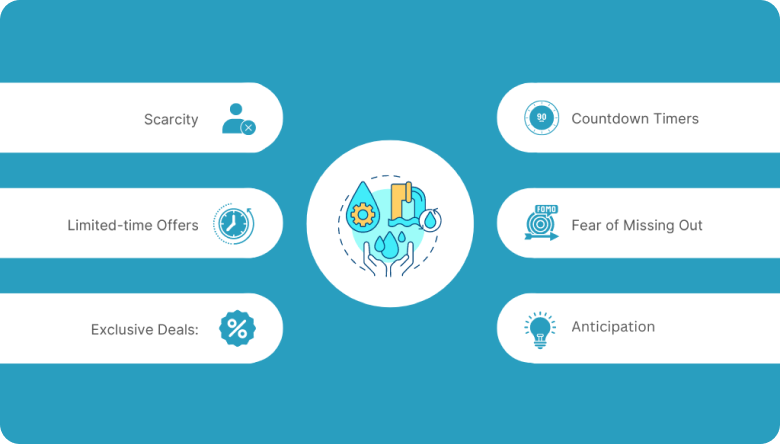
Scarcity: When something is rare, people want it more. Show limited stock or availability to create urgency. Apple uses this by releasing limited edition products that create excitement and demand.
Limited-time Offers: Set specific timeframes for discounts or promotions to make people act quickly. For example, Amazon’s “Deal of the Day” offers discounts for a short time, encouraging quick purchases.
Exclusive Deals: Offer special deals to select customers to make them feel special. VIP programs, like Sephora’s Beauty Insider, provide exclusive discounts and early access to new products, making customers feel valued.
Countdown Timers: Use countdown timers on your website or emails to show how much time is left for an offer. This visual cue encourages immediate action. Booking.com uses timers to show the time left to book a discounted hotel room.
Fear of Missing Out (FOMO): People don’t want to miss out on something exciting. Highlight the unique benefits of your product to create FOMO. Ticket sites like StubHub use phrases like “limited tickets remaining” to drive sales.
Anticipation: Build excitement for new products or events by teasing them early. Use sneak peeks and pre-order options to create anticipation. Nintendo, for example, releases teaser trailers and limited pre-orders to hype new game releases.
Adding these triggers related to scarcity and urgency to your sales and marketing strategies can help drive customer engagement, increase conversions, and boost sales.
3. Cognitive Triggers
Cognitive triggers tap into how our minds process information and make decisions, allowing businesses to influence purchasing choices effectively.
Here you will learn the importance of cognitive triggers and get practical ideas on incorporating persuasion techniques into your marketing strategies to increase conversions and drive customer engagement.
Anchoring and Framing: Start with a high-priced option (anchor) to make lower-priced ones (framing) seem like a better deal. Apple does this by showing expensive products first.
Loss Aversion: People hate losing more than they love gaining. Show your product as a way to avoid loss. Geico highlights potential financial losses without insurance to persuade people to buy.
Risk Reversal: To make people feel safe, reduce the risk of buying by offering guarantees, warranties, or trial periods. Zappos offers hassle-free returns, so customers can shop with confidence.
Preemptive Selling: Address concerns before customers ask. Provide detailed info and FAQs upfront. Apple’s website answers common questions early to build trust.
Cognitive Dissonance: Highlight the gap between current behavior and your product’s benefits. Fitbit shows the difference between health goals and current activity to encourage buying their trackers.
4. Emotional and Identity Triggers
Building a strong emotional connection with customers is a powerful way to drive engagement and boost conversions.
Businesses can tap into customers’ deep-rooted emotions, personal aspirations, and social identities by leveraging emotional and identity triggers.
We will explore the importance of emotional and identity triggers and provide practical ideas on connecting with customers emotionally to increase conversions and foster long-term loyalty.
Emotional Triggers: Emotions influence buying decisions. Understand your audience’s emotions and align your marketing to create a strong connection. Nike’s “Just Do It” inspires motivation and determination.
Storytelling: Use stories to connect with your audience. Share narratives that resonate with their experiences and values. Airbnb’s “Belong Anywhere” campaign shares heartwarming travel stories to build emotional connections.
Likability and Personal Connection: People prefer brands they like and feel connected to. Show your brand’s personality and values to build genuine connections. Ben & Jerry’s connects with customers through their social activism.
Social Identity: Align your brand with your customers’ social identities. Red Bull connects with extreme sports enthusiasts, positioning itself as the drink for adrenaline junkies.
Personal Goals and Aspirations: Understand your customers’ goals and show how your product helps achieve them. Peloton appeals to fitness enthusiasts by offering convenient home workouts.
Visualization: Help customers see the benefits of your product. Use visuals and descriptions to show the positive outcomes. Weight loss programs like WW use before-and-after photos to inspire potential success.
Nostalgia: Tap into positive memories from the past to create emotional connections. Coca-Cola’s holiday ads evoke nostalgia with heartwarming scenes and classic holiday imagery.
Related post: 88 Trigger Words to Ignite Rapid Conversions
5. Persuasion and Influence Strategies
Mastering persuasion and influence strategies are crucial for businesses aiming to convince customers to purchase.
By understanding and employing various psychological triggers, brands can effectively sway consumer behavior and drive sales.
We will explore three powerful persuasion and influence strategies: reciprocity, consistency, commitment, novelty, and innovation.
- Reciprocity: Give something first to make people feel they should give back. Sephora gives free beauty samples to encourage future purchases.
- Consistency and Commitment: Start with small commitments to lead to bigger ones. MyFitnessPal asks users to set goals, making them stay engaged and more likely to upgrade.
- Novelty and Innovation: People love new things. Introduce unique features or products to catch attention. Apple creates excitement with new iPhone features.
Also See: Role of Social Influence on Consumer Trust Decisions
6. Enhancing Customer Experience
A personalized customer experience is essential for driving sales and fostering customer loyalty.
By tailoring your offerings to individual preferences and needs, you can create a deeper connection with customers and enhance their overall experience.
We will explore critical triggers for enhancing customer experience and driving sales through personalization.
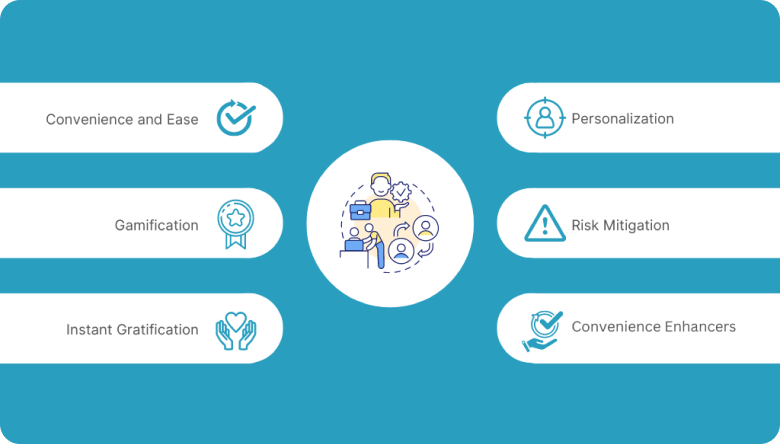
Convenience and Ease: Make shopping easy with simple interfaces and fast checkout. Amazon’s one-click ordering is a great example.
Gamification: Add fun elements like rewards and challenges to engage customers. Nike’s NikeFuel system makes exercise a game by tracking activity and giving rewards.
Do you want to dive into this more? Here you go: E-commerce Gamification: 3 Genius Examples + Your Roadmap
Instant Gratification: Offer quick results like fast shipping or instant downloads. Netflix provides instant streaming of movies and shows.
Personalization: Tailor recommendations and offers to individual preferences. Spotify creates personalized playlists based on users’ listening habits.
Risk Mitigation: Reduce purchase fears with clear return policies, guarantees, or free trials. Shopify offers a 14-day free trial to let customers test their platform.
Convenience Enhancers: Add features that make shopping even easier. Uber saves payment details and allows quick ride requests.
Focus on providing convenience and ease, leveraging gamification techniques, offering instant gratification, implementing personalization strategies, mitigating risks, and enhancing convenience throughout the customer journey.
Build trust & FOMO
Highlight real-time activities like reviews, sales & sign-ups.
7. Exclusivity and Status Triggers
Exclusivity triggers tap into people’s desire for unique experiences and products, while social validation triggers capitalize on the power of social proof and influence.
We will explore the importance of exclusivity and status triggers and provide practical ideas on incorporating them into your marketing strategies to increase sales and drive customer engagement.
Exclusivity: Offer limited access or unique experiences to a select group to make customers feel special. Luxury brands like Louis Vuitton use limited edition collections to create this sense of privilege.
Social Validation: Use positive reviews and user-generated content to show that others trust and benefit from your products. TripAdvisor shows user reviews and ratings to help travelers make decisions.
Price Anchoring: Present higher-priced options alongside lower-priced ones to make the latter seem more affordable. Adobe uses this strategy with different pricing tiers for their software.
VIP Access: Reward loyal customers with special privileges like exclusive discounts or early access. Amazon Prime offers benefits like free shipping and exclusive deals to its members.
Social Comparison: Highlight how your product can enhance customers’ status. Rolex emphasizes the prestige of owning their watches, appealing to those seeking recognition from others.
By tapping into these triggers, you can create a sense of exclusivity, elevate your brand’s status, and drive sales by appealing to customers’ desires for unique experiences and social validation.
8. Ethical and Social Responsibility
Embracing ethical and socially responsible strategies enhances brand reputation and establishes a genuine connection with customers who prioritize sustainability and social issues.
In this article, we will explore the importance of ethical and social responsibility in sales and provide practical ideas on how to incorporate these values into your marketing strategies to make a positive difference in the world.
Social Responsibility: Consider how your business affects society. Treat employees fairly, source responsibly, and minimize environmental impact. Patagonia uses recycled materials and supports environmental causes.
Sustainability and Ethics: Focus on eco-friendly and ethical practices to attract conscious consumers. The Body Shop is known for its stance against animal testing and using natural ingredients.
Cause-related Marketing: Partner with nonprofits to support a cause. TOMS donates a pair of shoes for each one bought, aligning with social impact and purpose.
Philanthropy: Give back to the community through donations or initiatives. Starbucks supports education and community development through its foundation.
Community Engagement: Build strong local ties by participating in events and sponsoring teams. Google’s Community Grants program funds local nonprofit organizations.
9. Curiosity and Intrigue
By utilizing psychological triggers related to curiosity and intrigue, businesses can create compelling marketing campaigns that pique the interest of their target audience.
We will explore the importance of curiosity and intrigue in captivating customers.
We will also provide practical ideas on how to incorporate these triggers into your marketing strategies to drive engagement and increase conversions.
Curiosity: Create marketing campaigns that make people eager to know more. Apple’s secretive product announcements build curiosity among customers.
Teasers and Mystery Offers: Use teasers to spark interest and anticipation. Video game companies release teaser trailers to build excitement about new games.
Exclusive Information: Share behind-the-scenes looks or insider tips to make customers feel special. Tesla shares exclusive info about new cars, generating excitement.
Hidden Benefits: Gradually reveal unique features of your products to create intrigue. Google includes hidden Easter eggs in its search engine, encouraging users to explore.
Unconventional Approaches: Use unique and unexpected marketing tactics to grab attention. The Dollar Shave Club’s funny and unconventional video went viral and increased brand awareness.
Incorporating these triggers of curiosity and intrigue into your marketing strategies can help captivate customers and drive engagement.
10. Authority and Expertise
Building trust and influence is crucial in the world of sales. Establishing yourself or your brand as an authority in your industry can significantly impact customer perceptions and drive sales.
By leveraging psychological triggers related to authority and expertise, businesses can instill confidence in their target audience, build credibility, and influence purchase decisions.
In this article, we will explore the importance of authority and expertise in sales and provide practical ideas on how to incorporate these triggers into your sales strategies to build trust and influence.
Authority Bias: People trust recommendations from authoritative figures. Showcase endorsements from experts or influencers. For example, a famous chef endorsing a kitchen appliance boosts its credibility.
Industry Expertise: Share valuable insights and tips to show your deep knowledge. HubSpot offers educational content on its blog, making it a trusted source in inbound marketing.
Thought Leadership: Contribute to industry discussions and share original insights. Neil Patel shares detailed marketing advice on his blog, establishing himself as a thought leader.
Certifications and Accreditations: Highlight your certifications to prove your expertise. A financial advisor displaying CFP or CFA certifications builds trust and credibility.
Research and Data-driven Insights: Support your claims with solid research and data. Statista provides comprehensive research reports, positioning itself as a reliable source of market data.
Using these triggers related to authority and expertise in your sales strategies can significantly enhance your influence and build trust with your target audience.
Remember to leverage authority bias, demonstrate industry expertise, establish thought leadership, highlight certifications and accreditations, and back your claims with research and data-driven insights.
11. Self-Expression Triggers
Understanding and tapping into customers’ identities is a powerful way to drive sales.
By leveraging psychological triggers related to self-expression, social belonging, and problem-solution alignment, businesses can connect with their target audience on a deeper level.
In this article, we will explore the importance of self-expression triggers in sales and provide practical ideas on how to incorporate them into your marketing strategies to boost customer engagement and drive conversions.
Social Belonging: People want to feel part of a group. Harley-Davidson makes riders feel like they belong to a community.
Problem-Solution Alignment: Show how your product solves a problem that matches customers’ values. Patagonia appeals to people who care about the environment.
Self-Expression: Let customers personalize products to show their unique style. Nike’s “Nike By You” lets customers design their own sneakers.
These self-expression triggers in your sales and marketing strategies can help create a solid emotional connection with your target audience.
12. Surprise and Delight
Creating memorable customer experiences can be the key to building long-lasting relationships and driving repeat business.
By incorporating the psychological triggers of surprise and delight, businesses can exceed customer expectations, foster loyalty, and generate positive word-of-mouth.
We will explore the importance of surprise and delight in sales and provide practical ideas for creating memorable customer experiences.
Story of Transformation: Share how your product changes lives. Lululemon highlights inspiring transformations from their customers.
Surprise and Delight: Surprise customers with thank-you notes or gifts. Zappos occasionally upgrades shipping or includes gifts to delight customers.
Sharing compelling stories of transformation and surprising customers with unexpected gestures can leave a lasting impression, fostering loyalty and positive brand associations.
Build trust & FOMO
Highlight real-time activities like reviews, sales & sign-ups.
Conclusion
In conclusion, incorporating psychological sales triggers into your marketing strategies can revolutionize your business.
Harness social proof, scarcity, cognitive and emotional triggers, persuasion strategies, exclusivity, ethics, curiosity, authority, self-expression, and surprise to influence purchases, boost conversions, and create memorable experiences.
Leveraging testimonials, reviews, and user-generated content to build trust, create a sense of urgency through countdown timers and limited-time offers, and optimize your marketing campaigns, our user-friendly platform empowers you to drive conversions and achieve remarkable results.
Don’t miss out on the opportunity to harness the power of social proof and FOMO.
Visit our website to join our community of successful businesses today.
Elevate your sales and marketing efforts with the WiserNotify app and unlock new levels of success for your business.
Remember, each psychological sales trigger uniquely connects with your target audience and influences their purchasing decisions.
Embrace these triggers, leverage our social proof and FOMO app, and embark on a journey to transform your business’s success.
Visit our website now and start experiencing exceptional sales and marketing outcomes.
In the end, you should combine this knowledge of triggers with social proof & FOMO tools to get more benefits.
